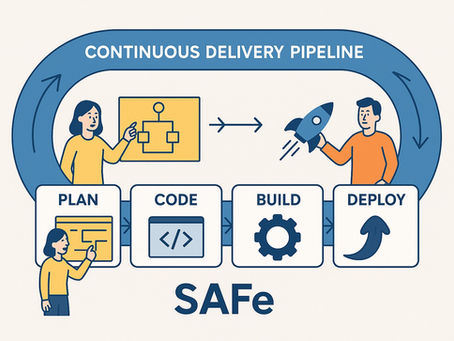top of page
Search


Tier 2 Consulting Firms: Selecting the Right Tier 2 Consulting Partner
Tier 2 consulting firms deliver strong value for enterprises that require expert support, practical delivery, and cost efficient consulting engagement models. Their combination of speed, flexibility, depth of expertise, and collaborative working styles makes them powerful partners for complex transformation.

Michelle M
3 days ago5 min read


Agile Quotes: Inspiring Agile Transformation Through Words
Agile Quotes may seem simple, but they play a profound role in shaping enterprise culture and sustaining transformation. They remind teams why agility matters, inspire leadership reflection, and connect people emotionally to organizational goals.

Michelle M
Nov 146 min read


Agile Prioritisation Techniques: How to Align Strategy and Execution
Agile Prioritisation Techniques provide the structure and transparency large enterprises need to deliver value consistently. By aligning strategic objectives with day-to-day execution, these techniques ensure that every initiative contributes directly to measurable business outcomes.

Michelle M
Nov 126 min read


Agile Foundation: Establishing the Building Blocks of Agile Change
A strong Agile Foundation is the cornerstone of enterprise transformation. It provides the structure, culture, and capabilities required to scale agility sustainably across complex global organizations.

Michelle M
Nov 75 min read


Agile Transformation Roadmap: From Vision to Execution
An Agile transformation roadmap is far more than a sequence of steps it is a strategic framework that connects vision with execution. For large enterprises, it provides clarity, governance, and momentum across complex ecosystems. By following a structured roadmap, organizations can transform incrementally while maintaining stability, ensuring that agility becomes a permanent driver of success rather than a temporary initiative.

Michelle M
Nov 45 min read


Agile vs Scrum vs Waterfall: Understanding the Key Differences
Agile, Scrum, and Waterfall each serve a purpose within enterprise project management. Agile drives adaptability and innovation. Scrum operationalizes Agile at the team level. Waterfall ensures structure and compliance for predictable outcomes. Large organizations that understand how to combine these approaches strategically will achieve balance between control and creativity, enabling sustainable digital transformation and long-term competitiveness.

Michelle M
Nov 35 min read


Agile Nearshore: Enhancing Speed and Quality at Scale
Agile nearshore delivery has become a cornerstone of enterprise agility. It combines the flexibility of local collaboration with the efficiency of global resourcing. By embedding nearshore partners within their Agile frameworks, large organizations can accelerate delivery, maintain quality, and scale sustainably.

Michelle M
Nov 35 min read


AI SEO Tools Scale Agile Solutions: Enabling Enterprise Growth
AI SEO tools have moved from optional enhancements to strategic enablers for enterprise agility. When combined with scaled Agile frameworks, they enable organizations to deliver high-performing digital experiences with speed, precision, and governance.

Michelle M
Nov 25 min read


Event Management Project: How to Execute Events with Precision
Event management projects are no longer simple logistical undertakings they are strategic corporate operations that drive business growth, engagement, and brand leadership.

Michelle M
Nov 26 min read


Start to Finish Project Management: A Corporate Lifecycle Approach
Start to finish project management represents the complete lifecycle of corporate project governance. It integrates strategy, execution, and evaluation into a unified process that strengthens accountability and performance.

Michelle M
Nov 26 min read


Product Experience Management: Best Practices for Businesses
Product Experience Management is transforming how businesses engage with customers. It connects accurate data, emotional storytelling, and smart technology to create meaningful, consistent, and personalized product interactions.

Michelle M
Oct 297 min read


Why Do Agile Teams Use Iteration Goals to Drive Success
Iteration goals are at the core of effective Agile project management. They translate strategy into action, align teams around shared objectives, and ensure that every sprint delivers value that matters. By defining clear outcomes, teams stay focused, motivated, and adaptable in the face of change.

Michelle M
Oct 268 min read


Custom MVP Software Development: Turning Ideas into Successful Products
Custom MVP software development is one of the smartest approaches for launching a new digital product. It combines speed, precision, and flexibility, allowing businesses to learn what users truly want before investing heavily.
A well-executed MVP can save time, reduce costs, and set the foundation for long-term success. It transforms an abstract idea into a working product that provides real value to customers and solid insights for businesses.

Michelle M
Oct 246 min read


Project Management vs Scrum Master: Leadership Styles Compared
Both the Project Manager and the Scrum Master play vital roles in modern project execution. While their responsibilities and methodologies differ, their shared goal is delivering successful projects that provide value.

Michelle M
Oct 207 min read


Azure DevOps vs Jira: Choosing the Right Tool for DevOps Success
The debate of Azure DevOps vs Jira is not about which tool is better, but which one fits your organization’s workflow best. Azure DevOps excels as an all-in-one solution for teams seeking full lifecycle management, while Jira remains the gold standard for agile project management with an extensive integration ecosystem.

Michelle M
Oct 198 min read


How Long Does It Take to Become a Software Engineer for Beginners
So, how long does it take to become a software engineer? The answer depends on your background, chosen learning path, and dedication. A college degree may take around four years, while a bootcamp or self-learning route could take less than two. Regardless of how long it takes, persistence and consistent practice will ultimately determine your success

Michelle M
Oct 187 min read


Kamishibai Board: A Powerful Tool for Lean and Continuous Improvement
Kamishibai boards are gaining popularity beyond manufacturing. They are now used in hospitals to monitor patient safety, in offices to manage projects, and even in schools to teach visual organization.
Digital Kamishibai systems are emerging as well, integrating the traditional board with online dashboards. These tools allow for remote monitoring and real-time updates, especially valuable in global organizations.

Michelle M
Oct 57 min read


Scrum Glossary: The Complete Guide
Scrum is one of the most widely used agile frameworks, empowering teams to deliver value iteratively and collaboratively. To fully understand Scrum, it helps to know the essential terms, roles, and artifacts that form its foundation. This Scrum glossary serves as a comprehensive guide, offering clear explanations of over 100 key concepts that every Scrum practitioner, project manager, or agile team member should know.

Michelle M
Aug 256 min read


Scrum vs Waterfall: Which Project Methodology Is Best for You?
In project management, selecting the right methodology can mean the difference between success and failure. Two of the most prominent frameworks Scrum and Waterfall offer fundamentally different approaches to managing and delivering projects. This blog will explore the differences between Scrum and Waterfall in detail, helping you understand when to apply each and how they impact planning, execution, collaboration, and outcomes.

Michelle M
Jul 285 min read


Continuous Delivery Pipeline SAFe: A Detailed Guide
In this blog will explore what the Continuous Delivery Pipeline in SAFe is, how it works, why it matters, and how to successfully implement and optimize it within your enterprise.

Michelle M
Jul 15 min read
bottom of page
